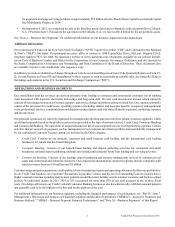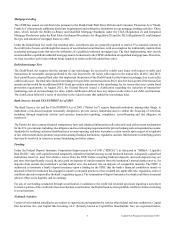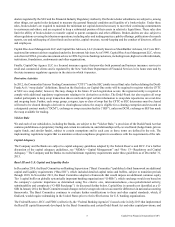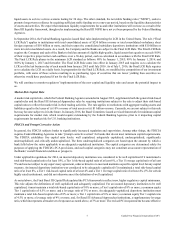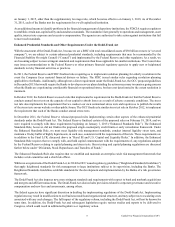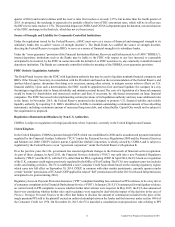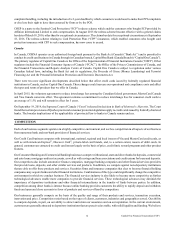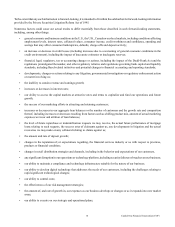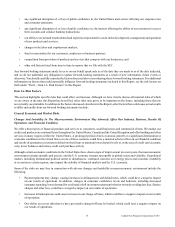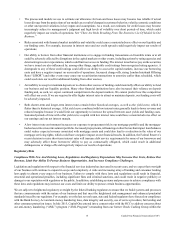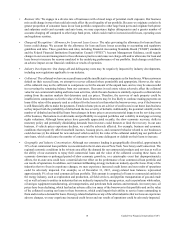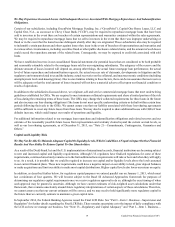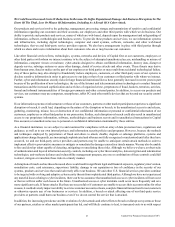Capital One 2015 Annual Report Download - page 30
Download and view the complete annual report
Please find page 30 of the 2015 Capital One annual report below. You can navigate through the pages in the report by either clicking on the pages listed below, or by using the keyword search tool below to find specific information within the annual report.11 Capital One Financial Corporation (COF)
quarter of 2016) and would continue until the reserve ratio first reaches or exceeds 1.35%, but no later than the fourth quarter of
2018. As proposed, the surcharge is expected to be partially offset by lower FDIC assessment rates, which will be in effect once
the DIF reserve ratio reaches 1.15%. The potential impact on COBNA and CONA is dependent upon the duration, rate and structure
of the FDIC surcharge in the final rule, which has not yet been issued.
Source of Strength and Liability for Commonly-Controlled Institutions
Under the regulations issued by the Federal Reserve, a BHC must serve as a source of financial and managerial strength to its
subsidiary banks (the so-called “source of strength doctrine”). The Dodd-Frank Act codified the source of strength doctrine,
directing the Federal Reserve to require BHCs to serve as a source of financial strength to its subsidiary banks.
Under the “cross-guarantee” provision of the Financial Institutions Reform, Recovery and Enforcement Act of 1989 (“FIRREA”),
insured depository institutions such as the Banks may be liable to the FDIC with respect to any loss incurred, or reasonably
anticipated to be incurred, by the FDIC in connection with the default of, or FDIC assistance to, any commonly controlled insured
depository institution. The Banks are commonly controlled within the meaning of the FIRREA cross-guarantee provision.
FDIC Orderly Liquidation Authority
The Dodd-Frank Act provides the FDIC with liquidation authority that may be used to liquidate nonbank financial companies and
BHCs if the Treasury Secretary, in consultation with the President and based on the recommendation of the Federal Reserve and
another federal agency, determines that doing so is necessary, among other criteria, to mitigate serious adverse effects on U.S.
financial stability. Upon such a determination, the FDIC would be appointed receiver and must liquidate the company in a way
that mitigates significant risks to financial stability and minimizes moral hazard. The costs of a liquidation of a financial company
would be borne by shareholders and unsecured creditors and then, if necessary, by risk-based assessments on large financial
companies. The FDIC has issued rules implementing certain provisions of its liquidation authority and may issue additional rules
in the future. In November 2015, the Federal Reserve proposed rules designed to promote U.S. financial stability and orderly
liquidity authority by requiring U.S. BHCs identified as G-SIBs to maintain outstanding a minimum amount of loss absorbing
instruments, including a minimum amount of unsecured long-term debt, and related buffer. Capital One would not be subject to
this requirement as proposed.
Regulation of International Business by Non-U.S. Authorities
COBNA is subject to regulation in foreign jurisdictions where it operates, currently in the United Kingdom and Canada.
United Kingdom
In the United Kingdom, COBNA operates through COEP, which was established in 2000 and is an authorized payment institution
regulated by the Financial Conduct Authority (“FCA”) under the Payment Services Regulations 2009 and the Financial Services
and Markets Act 2000. COEP’s indirect parent, Capital One Global Corporation, is wholly-owned by COBNA and is subject to
regulation by the Federal Reserve as an “agreement corporation” under the Federal Reserve’s Regulation K.
Over the past few years the U.K. government has enacted significant changes to the framework of financial services regulation.
As part of these changes, in April 2013, the Financial Services Authority (“FSA”) was split into a new Prudential Regulatory
Authority (“PRA”) and the FCA, with the FCA, rather than the PRA, regulating COEP. In April 2014, the FCA took over regulation
of the U.K. consumer credit regime previously regulated by the Office of Fair Trading. The FCA’s new regulatory purview includes
credit card lending activities. The FCA established a new Consumer Credit Sourcebook based on the existing regulatory regime
which came into full effect on September 30, 2014. COEP, in common with other market participants, currently operates under
certain “interim” permissions of FCA and COEP applied for related “full” permissions in October 2015 (with such full permissions
anticipated to be granted during 2016).
Regulatory focus on Payment Protection Insurance (“PPI”) complaint handling has continued as PPI continues to be a key driver
of consumer complaints to the Financial Ombudsman Service (“FOS”). In January 2015, FCA announced it would gather evidence
on current trends in PPI complaints to assess whether further interventions were required. In May 2015, the FCA also announced
that it was considering whether further rules and/or guidance were required to deal with the impact of the decision in the case of
Plevin v. Paragon Personal Finance to the effect that failure to disclose the amount of commission included in the price of the
single premium PPI sold to the plaintiff created an unfair relationship between the lender and the borrower under section 140A of
the Consumer Credit Act 1974. On November 26, 2015, the FCA launched a consultation on proposed new rules relating to PPI



